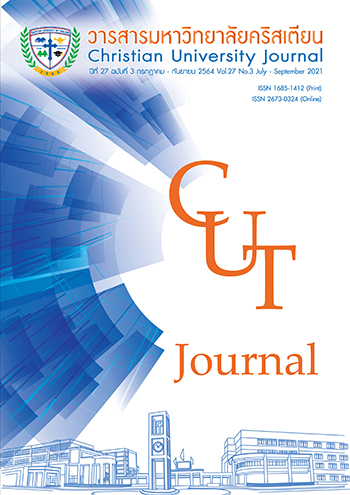การควบคุมการเจริญของเซลล์มะเร็งโดยที-เซลล์และจุลินทรีย์ในลำไส้
คำสำคัญ:
เซลล์มะเร็ง, ที-เซลล์, อะพอพโทซิส, โพรไบโอติก/จุลินทรีย์ในลำไส้บทคัดย่อ
ปัจจุบันโรคมะเร็งจัดเป็นสาเหตุการเสียชีวิตอันดับที่หนึ่งของมนุษย์โดยมีสาเหตุมาจากปัจจัยด้านอาหารมากที่สุด โรคมะเร็งสามารถเกิดได้กับคนทุกเพศทุกวัยและพบในทุกอวัยวะของร่างกาย การรักษามีเป้าหมายหลักคือการกำจัดเซลล์มะเร็งออกจากร่างกายให้ได้มากที่สุดด้วยการผ่าตัด การฉายแสง (รังสีบำบัด) และเคมีบำบัด
บทความวิชาการนี้นำเสนอองค์ความรู้ด้านชีววิทยาระดับโมเลกุลทั้งสาเหตุการเกิดและการควบคุมการเจริญของเซลล์มะเร็งด้วยระบบภูมิคุ้มกันที-เซลล์ และกลไกที่จุลินทรีย์ในร่างกายโดยเฉพาะอย่างยิ่งในลำไส้ (Gut microbiota) ที่ส่งเสริมระบบภูมิคุ้มกันของร่างกายให้มีประสิทธิภาพหรือตอบสนองต่อการรักษาโรคมะเร็งดีขึ้นกว่าเดิม
เอกสารอ้างอิง
ทะกะโฮะ วะตะโย. (2562). มะเร็งหายด้วยอาหาร. (ชาญ ธนประกอบ, ผู้แปล). (พิมพ์ครั้งที่ 7). กรุงเทพฯ: อินสปายร์.
เทพ เฉลิมชัย. (2016). การรักษามะเร็งผิวหนังเมลาโนมาระยะแพร่กระจาย. Journal of Medicine and Health Sciences, 23 (3), 50-62.
ธัชนันท์ พรธารักษ์เจริญ และ ปนัดดา ศรีจอมขวัญ. (2562). ความผิดปกติของระบบต่อมไร้ท่อจากการใช้ยายับยั้งการทำงานที่อิมมูนเช็คพอยต์. วารสารวิชาการราชวิทยาลัยจุฬาภรณ์, 1(2), 35–52.
ปิติ จันทร์วรโชติ. (2560). ชีววิทยาโมเลกุลของเซลล์มะเร็ง. กรุงเทพฯ: จุฬาลงกรณ์มหาวิทยาลัย.
ภูริตา ทองกิจปรีชา ธีรยุทธ ปิ่นแก้วและภัชษร อัคนนิธิธนยศ. (2563). Atezolizumab ในมะเร็งเต้านมชนิด Triple Negative. วารสารโรคมะเร็ง, 40 (1), 53-61.
มาลินี ธานี, พวงรัตน์ ยงวณิชย์, และวัชรินทร์ ลอยลม. (2555). องค์ประกอบและบทบาทของสภาวะแวดล้อมของเซลล์มะเร็ง. ศรีนครินทร์เวชสาร, 27(4), 424-432.
ลลิตา ธีระสิริ, (2552). มะเร็ง-รักษาด้วยตนเองตามแนวธรรมชาติบำบัด. กรุงเทพฯ: รวมทรรศน์.
สถาบันมะเร็งแห่งชาติ. (2563). ทะเบียนมะเร็งระดับโรงพยาบาล พ.ศ. 2562. สืบค้นจาก: http://thaicancernews.nci.go.th/_v2/index.php/2019/12/31/kb2901li2479kj/
สุพรรณิการ์ ถวิลหวัง. (2017). ภูมิคุ้มกันบำบัดมะเร็ง: ความสำเร็จของการรักษาด้วยเซลล์ภูมิคุ้มกัน. วารสารเภสัชวิทยา, 39(2), 49–61.
สิทธัตถะ มุกเคอร์จี. (2556).จักรพรรด์แห่งโรคร้าย ชีวประวัติของโรคมะเร็ง. [The Emperor of All Maladies: A Biography of Cancer] (สุนันทา วรรณสิทธ์ เบล, ผู้แปล). กรุงเทพฯ: มติชน.
เอกภพ ญาณยุตฺโต. (2562). แค่รู้วิธี ชาตินี้เราจะไม่เป็นมะเร็ง. กรุงเทพฯ: อมรินทร์เฮลท์อมรินทร์พริ้นติ้งแอนด์พับลิชชิ้ง.
Abrams, J., Telford, W.G., & Rollins, L. (2014). The many roads to cell death: discriminating between apoptosis, necrosis and autophagy. DDW, 41-46.
Anand, P., Kunnumakara, A.B., Sundaram, C., & et al. (2008). Cancer is a preventable disease that requires major lifestyle changes. Pharmaceutical Research, 25(90), 2097-2116.
Ayelet, S., Leticia, C., Nathaniel, H., & et al. (2015). Commensal bifidobacterium promotes antitumor immunity and facilitates anti-PD-L1 efficacy. Science, 350, 1084-1089.
Azad, M. A. K., Sarker, M., & Wan, D. (2018). Immunomodulatory effects of probiotics on cytokine profiles. BioMed Research International, 2018, 1-10.
Canani, R.B., & et al. (2011). Potential of beneficial effects of butyrate in intestinal and extra intestinal diseases. World Journal of Gastrointestinal, 17, 15-19.
Chamber, E.S., Preston, T., Frost, G., & Morrison, D.J. (2018). Role of gut microbiota-generated short-chain fatty acids in metabolic and cardiovascular health. Current Nutrition Report, 7, 198-206.
Chamcorachote, P., & et al. (2009). Curcumin Sensitizes lung cancer cells to clisplatin induced apoptosis through superoxide anion-mediated Bcl-2 degradation. Cancer Investigation, 27, 624-635.
Chaput, N., Lepage, P., Coutzac, C., & et al. (2017). Baseline gut microbiota predicts clinical response and colitis in metastatic melanoma patients treat with ipilimumab. Annals of Oncology, 28(6), 1368-1379.
Chipuk, J. E., & et al. (2010). The BCL-2 famiy reunion. Molecular cell 37, 299-310.
Elkrief, A., Derosa, L., Zitvogel, L., Kroemer, G., & Routy, B. (2019). The innate relationship between gut microbiota and cancer immunotherapy, Gut Microbes, 10(3), 424-428.
Elmore, S. (2007). Apoptosis: a review of programmed cell death. Toxicology and Pathology, 35(4), 495-516.
Ferlay, J., Colombet, M., Soerjomataram, I., & et al. (2019). Estimating the global cancer incidence and mortality in 2018: GLOBOCAN Sources and Methods. International Journal of Cancer, 144(8), 1941-1953.
Fernández, M. F., Reina-Pérez, I., Astorga, J. M., Rodríguez-Carrillo, A., Plaza-Díaz, J., & Fontana, L. (2018). Breast cancer and its relationship with the microbiota. International journal of environmental research and public health, 15(8), 1747. doi.org/10.3390/ijerph15081747
Fong, W., Li, Q., & Yu, J. (2020). Gut microbiota modulation: a novel strategy for prevention and treatment of colorectal cancer. Oncogene, 39, 4925-4943.
Gao, Z., Gao, B., Gao, R., Zhu, Q., Wu, W., & Qin, H. (2015). Probiotics modify human intestinal mucosa-associated microbiota in patients with colorectal cancer. Molecular Medicine Reports, 12, 6119-6127.
Gill, S.R., Pop, M., Deboy, R.T., & et al. (2006). Metagenomic analysis of the human distal gut microbiome. Science, 312, 1355-1359.
Hussan, H., Clinton, S.K., Roberts, K., & Bailey, M.T. (2017). Fusobacterium’s link to colorectal neoplasia sequenced: A systematic review and future insights. World Journal of Gastroenterology, 23(48), 8626-8650.
Igney F. H., & Krammer, P. H. (2002). Immune escape of tumors: Apoptosis resistance and tumor counterattack. Journal of Leukocyte Biology, 71(6), 907-920.
Iwai, Y., Hamanishi, J, Chamoto, K., & Honjo, T. (2017). Cancer immunotherapies targeting the PD-1 signaling pathway. Journal of Biomedical Science (2017) 24, 26. doi:10.1186/ s12929-017-0329-9.
Jin, Y., Dong, H., Xia, L., & et al. (2019). The diversity of gut microbiome is associated with Favorable responds to anti-programmed death 1 immunotherapy in Chinese patients with NSCLC. Journal of Thoracic Oncology, 14(8), 1378-1389.
Khanna, S, & Tosh, P.K. (2014). A clinician’s primer on the role of the microbiome in human health and disease. Mayo Clinic Proceedings, 89(1), 107-114.
Kourie, H.R., & Klastersky, J.A. (2016). Side-effects of checkpoint inhibit-based combination therapy. Current Opinion in Oncology, 28(4), 306-313.
Kroemer, G., & Zitvogel, L. (2018). Cancer immunotherapy in 2017: The breakthrough of the microbiota. Nature Reviews Immunology, 18, 87-88.
Liu, F., Li, J., Guan, Y., & et al. (2019). Dysbiosis of the gut microbiome is associated with tumor biomarkers in lung cancer. International Journal of Biological Sciences, 15(11), 2381-2392.
Ogawa, T., & et al. (2005). Natural killer cell activities of synbiotic Lactobacillus casei ssp. Casei in conjunction with dextran. Clinical and Experimental Immunology, 143, 103-109.
Qin, J., Li, R., Raes, J., & et al. (2010). A human gut microbial gene catalogue established by metagenomic sequencing. Nature, 464, 59-65.
Sampsell, K., Hao, D., & Reimer, R. A. (2020). The gut microbiota: A potential gateway to improved health outcomes in breast cancer treatment and survivorship. International journal of molecular sciences, 21(23), 9239. doi.org/10.3390/ijms21239239
Shapiro, B.L. (2000). Cancer, genes, and the environment. The New England Journal of Medicine, 343(20), 1491-1496. doi.org/10.1056/NEJM200011163432013
Sivamaruthi, B.S., Kesika, P., & Chaiyasut, C. (2020). The role of probiotics in colorectal cancer management. Evidence-based Complementary and Alternative Medicine, 2020, 1-17.
Sivan, A., Corrales, L., Hubert, N., & et al. (2015). Commensal bifid bacterium promotes antitumor immunity and facilitates anti-PD-L1 efficacy. Science, 350, 1084-1089.
Sung, H., Ferlay, J., Siegel, R;L., & et al. (2021). Global cancer statistics 2020: GLOBOCAN Estimates of incidence and mortality worldwide for 36 cancers in 185 countries. A Cancer Journal for Clinicians, 0, 1-41. doi:10.332/caac.21660.
World Gastroenterology Organization. (2009). World gastroenterology organization practice guidelines: Probiotics and prebiotics. Arab Journal of Gastroenterology, 10, 33–42.



